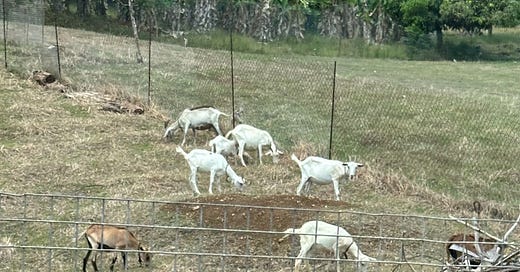Put It Where the Goats Can Get It: Plain Talk for Complex Times
“If you can’t dazzle them with brilliance, then baffle them with bullsh*t.” W.C. Fields
In a world brimming with complexity, nuance, and noise, the ability to communicate clearly has never been more critical. The late Joe Madison, the legendary Sirius XM radio host and activist, once exhorted then-President Barack Obama to “put it where the goats can get it”—a Southern phrase that captures the art of making complex ideas accessible. This folk wisdom, rooted in my upbringing in early 70s Alabama, speaks to the power of simplicity: truth must resonate with the common person, not just the intellectual elite.
This Substack is my attempt to do just that—to bridge the gap between high-minded ideas and everyday understanding. Here, provocative topics and thoughtful essays will be presented plainly, with the hope of sparking not just conversation, but principled action.
The Wisdom of “Where the Goats Can Get It”
Growing up in the South, I witnessed elders wield language like a tool, crafting phrases as vivid as they were instructive. Sayings like “put it where the goats can get it”, “a hit dog will holler”, and “even a broke clock is right twice a day”, were more than just colloquialisms—they were vessels of wisdom. The imagery was simple yet profound: goats graze low to the ground. If you want them to eat, you can’t hang their food on a wall; you must place it within reach.
The same logic applies to ideas. If people are to engage with them, those ideas must be clear, accessible, and relatable. Never has this principle been more urgent. Disinformation, misinformation, and polarization routinely drown out truth and reason. The stakes are too high for jargon, riddles, or evasion. Whether discussing social justice, climate change, or democracy, we must *“make it plain,”* as the Black church elders of my youth would declare. We must put truth where the goats can get it.
The Challenge of Communication in Complex Times
Joe Madison understood this challenge well. A master communicator, he knew that an idea’s power lies not just in its substance, but in its delivery. When he urged President Obama to “put it where the goats can get it,” he was advocating for leadership that meets people where they are—not by dumbing down complexity, but by breaking it down with intellectual honesty and emotional resonance.
As Gandhi taught, to move people to action, you must speak to their hearts as well as their minds. Today, in an age of soundbites and slogans—where a lie travels halfway around the world while truth is still putting on its shoes—this approach is essential. The ideas that shape our lives—justice, equality, freedom—require more than 280 characters. They demand clarity, honest dialogue, and a refusal to let nuance be sacrificed for virality.
What to Expect Here
In the coming weeks, this platform will be a place where big ideas are located where the goats can get them. As the late Barbara Jordan declared during Watergate: *“We are trying to be big, because the task before us is a big one.”*
We’ll tackle race, gender, reproductive justice, politics, faith, and more—drawing on Southern wisdom, thinkers like Joe Madison, and the lived experiences of everyday people. As Einstein observed, solving a problem requires greater intelligence than creating it. Our moment demands such thinking—complex yet clear.
This won’t be a soapbox for preaching, but a space for dialogue, discovery, and honest disagreement. I want to raise tough questions, challenge assumptions, and find common ground—pursuing truth not as a lofty ideal, but as a practical tool for navigating our world.
Let’s commit to speaking plainly, listening deeply, and engaging thoughtfully. Let’s make the complex simple, the abstract concrete, and truth accessible to all. Together, we can ensure everyone—no matter how low to the ground they may feel—can reach the nourishment they need to thrive.
Let’s “Put It Where the Goats Can Get It”, and let’s get to work.




Love the goats expression. Hadn’t heard it before—maybe because my hometown, Oak Ridge, TN didn’t really claim TN, and TN didn’t claim Oak Ridge, the Atomic City. There is so much about the south and its history that I do not own or agree with, but I am only now starting to acknowledge that wisdom doesn’t abide by geographic lines, and there is much about the south that is valuable. I have always felt that one cannot be critical of the south unless one grew up there or lives there now. Thanks Willie, for using language from the people of the south in such a meaningful way. I am taking notes and learning.